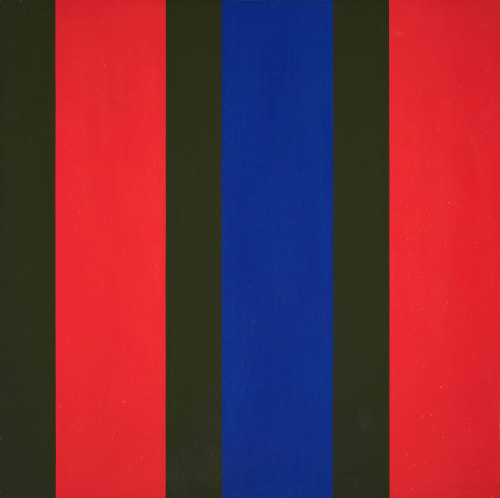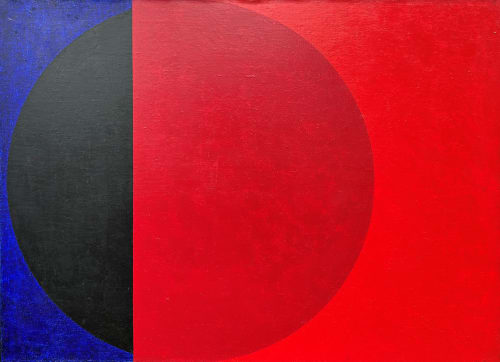Known for large, hard-edged abstractions, Oli T. Sihvonen, a Brooklyn native of Finnish ancestry, grew up in Connecticut. He attended the Norwich Art School before enrolling at the Art Students League in New York between 1938 and 1941. During World War II, Sihvonen served in the United States Army as a sergeant, specializing, as he later said, in “camouflage and deception.” His tour of duty took him to Europe where he encountered the work of Paul Cézanne.
In the summer of 1946, Sihvonen traveled to western North Carolina to study at Black Mountain College, which experienced a boost in enrollment following the war years. He was greatly influenced by the progressive color theories of Josef Albers, and, later, the thinking of Buckminster Fuller. After leaving Black Mountain in 1948, Sihvonen continued his studies under the G.I. Bill at Louis Ribak’s Taos Valley Art School in New Mexico from 1949 to 1950. A year spent painting murals in Mexico included work for the Instituto Politécnico Nacional in Mexico City, an early example of his large-scale proficiency. Returning to the East Coast, Sihvonen held a succession of teaching posts: initially in Washington, DC, and then in New York City, first at Hunter College in 1954 and the following academic year at Cooper Union.
Drawn to the southwestern landscape, Sihvonen moved to New Mexico, where he resided in Taos from 1956 through 1967. There, he painted sizeable geometric compositions with exuberant colors, which was atypical of Taos painters. One critic, Paul Goodman, assessed his style with the following description: “Sihvonen’s loving attention to the precise millimeter and the precise hue on the spectrum pays off in a floating and exciting calm and emotion; the picture is in motion, the colors leave their forms and come back changed. The canvas seems to generate its own light, not otherwise than in a bright noonday sun or in mysterious moonlight; there is a fullness of light.” Like Albers, Sihvonen often sought to create a chromatic environment where the brilliance of the colors produces a startling afterimage on the retina.
One of Sihvonen’s favorite shapes was the ellipse, as he considered it “active.” His well-known Ellipse series, represented by Double Matrix on Blue, dates to the 1960s. In geometry, an ellipse is a conic section, or the intersection of a two-dimensional plane and three-dimensional cone. By placing an ellipse within a rectangle, Sihvonen disrupts perception and accentuates the malleability of color.
While his canvases and diptychs received critical praise, Sihvonen once lamented that “dealers are not very interested in showing my work.” One exception was Betty Parsons, a proponent of modern art who accorded Sihvonen a one-man show at her eponymous New York gallery in 1962. Prestigious fellowships from the Yaddo Art Colony along with grants from the National Endowment for the Arts and the Wurlitzer, Pollock-Krasner, and Gottlieb foundations provided much-needed financial support. His work was included in significant exhibitions at the Museum of Modern Art and Whitney Museum of American Art in the late 1960s, and is today represented in these and other prestigious museums’ permanent collections.



